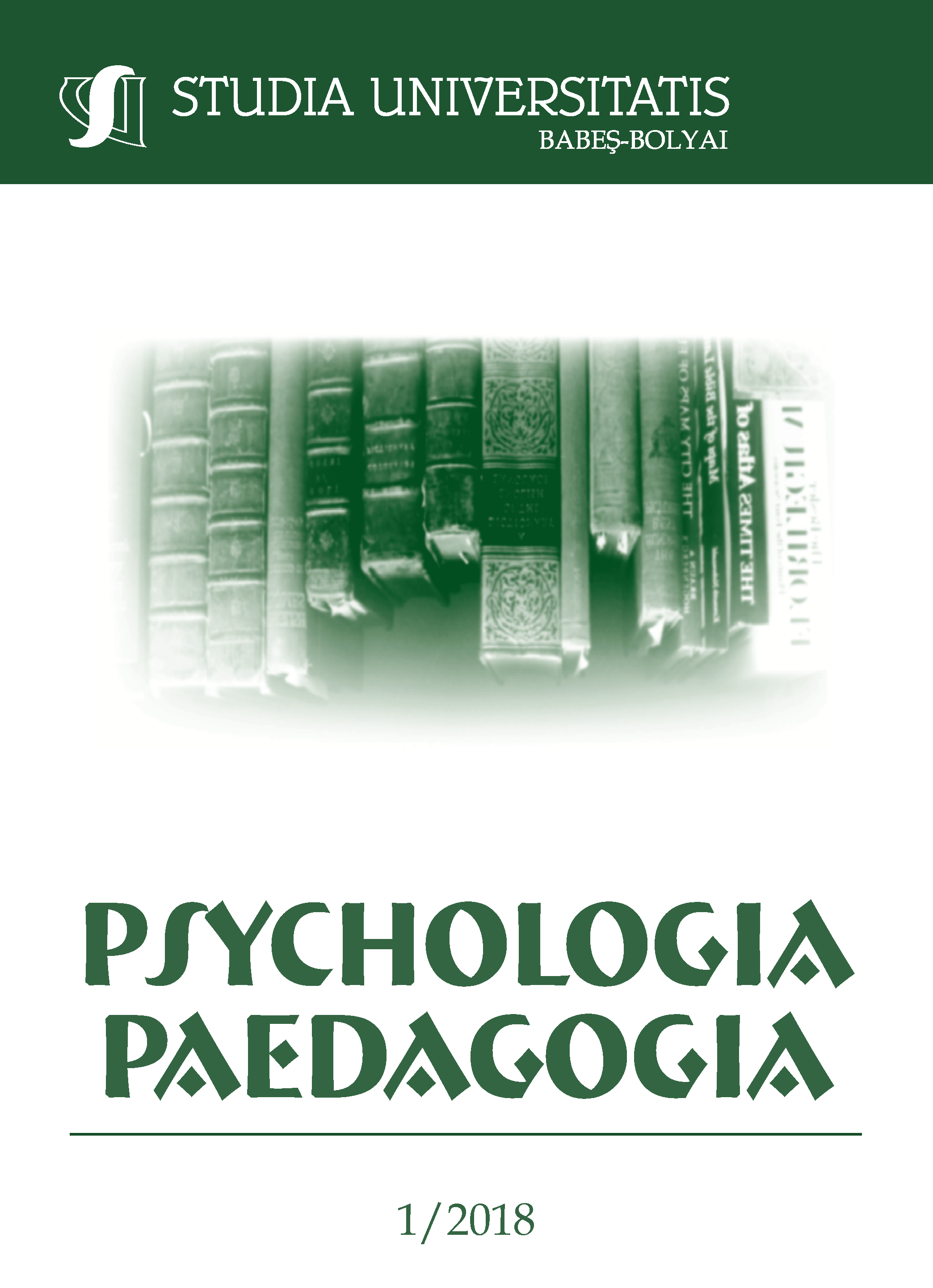EFFECT OF INTENSIVE TACT INSTRUCTION ON SPONTANEOUS VERBAL BEHAVIOR IN THREE CHILDREN WITH DEVELOPMENTAL DISABILITY
DOI:
https://doi.org/10.24193/subbpsyped.2018.1.05Keywords:
Intensive Tact Instruction, Tact, Mand, Disability, Verbal BehaviorAbstract
The present study is a partial replication of the intensive tact instruction tactic, in three students with developmental disability. The de-pendent variable was tacts emitted in Non Instructional Settings (NIS) prior and after the mastery of sets of 5 different stimuli. The NIS included the toy area of the classroom, lunchtime, and group activity. All probe sessions were conducted daily for a cumulative 15 minutes, 5 minutes in each NIS for three different days. Intensive tact instruction involved increasing the tact instructions to 100-tact learn units above the daily learn units students were receiving daily. The results showed a significant improvement of vocal verbal operants (tacts and mands) emitted by the students in natural environment.
Wirkung von intensiv Tact Anweisung auf spontanes Verbalverhalten bei drei Kindern mit Entwicklungsbehinderung. Die vorliegende Studie ist eine teilweise Replikation von “intensive tact Instruction Tactic”, in drei Studenten mit evolutionärer Behinderung. Die abhängige Variable war die Nummer von Tacts, die in unstrukturierten Kontexten vor und nach dem Erwerb von Sets 5 verschiedener Stimuli produziert werden. Die unstrukturierte Kontexte schlossen den Spielberich der Klasse, das Essen und Gruppenaktivitäten ein. Alle Probe-Sitzungen wurden täglich, für insgesamt 15 Minuten, 5 Minuten in jedem Kontext an 3 verschiedenen Tagen, durchgeführt. “Intensive Tact Instruction” umfasste die tägliche Zunahme von 100 Lernmöglichkeiten von “Tact” für jeden Schüler. Die Ergebnisse zeigen eine signifikante Zunahme der verbalen Stimmoperanten (Tacts und Mands), die die Schüler in natürlicher Umgebung produzierten.
Schlüsselwörter: Intensive Tact Instruction, Tact, Mand, Behinderung, Sprache
References
American Psychiatric Association (2013). DSM –V, Diagnostic and Statistical Manual of Mental Disorder (5th ed.), Washington DC.
Albers, A. E., & Greer, R. D. (1991). Is the three-term contingency trial a predictor of effective instruction? Journal of Behavioral Education, 1(3), 337-354.
Delgado, J. A. P., & Oblak, M. (2007). The effects of daily intensive tact instruction on the emission of pure mands and tacts in non-instructional set-tings by three preschool children with developmental delays. Journal of Early and Intensive Behavior Intervention, 4(2), 392-411.
Greenwood, C. R., Hart, B., Walker, D., & Risley, T. (1994). The opportunity to respond and academic performance revisited: A behavioral theory of developmental retardation and its prevention. Behavior analysis in education: Focus on measurably superior instruction, 213-223.
Greer, R. D., & Du, L. (2010). Generic instruction versus intensive tact instruction and the emission of spontaneous speech. The Journal of Speech and Language Pathology–Applied Behavior Analysis, 5(1), 1-19.
Greer, R. D., & Ross, D. E. (2008). Verbal behavior analysis: Inducing and expanding new verbal capabilities in children with language delays. Bos-ton, MA: Allyn & Bacon.
Greer, R. D., Stolfi, L., Chavez-Brown, M., & Rivera-Valdes, C. (2005). The emergence of the listener to speaker component of naming in children as a function of multiple exemplar instruction. The Analysis of Verbal Behavior, 21(1), 123-134.
Greer, R. F. (2002). Designing teaching strategies: An applied behavior analysis systems approach. New York: Academic Press.
Greer, R. D., & McDonough, S. H. (1999). Is the learn unit a fundamental measure of pedagogy? The behavior analyst, 22(1), 5-16.
Leaf, R., & McEachin, J. J. (1998). A work in progress: Behavior management strategies and a curriculum for intensive behavioral treatment of autism. New York: Different Roads to Learning.
Lodhi, S., & Greer, R. D. (1989). The speaker as listener. Journal of the Experimental Analysis of Behavior, 51(3), 353-559.
Lowe, C. F., Horne, P. J., Harris, F. D., & Randle, V. R. (2002). Naming and categorization in young children: Vocal tact training. Journal of the Experimental Analysis of Behavior, 78(3), 527-549.
Delgado, J. A. P., & Oblak, M. (2007). The effects of daily intensive tact instruction on the emission of pure mands and tacts in non-instructional set-tings by three preschool children with developmental delays. Journal of Early and Intensive Behavior Intervention, 4(2), 392.
Pistoljevic, N., & Greer, R. D. (2006). The effects of daily intensive tact instruction on preschool students' emission of pure tacts and mands in non-instructional setting. Journal of Early and Intensive Behavior Intervention, 3(1), 103-120.
Schauffler, G. & Greer, D. (2006). The effects of intensive tact instruction on audience-accurate tacts and conversational units. Journal of Early and Intensive Behavior Intervention, 3(1), 121–134.
Skinner, B.F. (1957). Verbal Behavior. Acton, MA: Copley Publishing Group.
Stevens, M., Fein, D. Dunn, M., Allen, D. Waterhouse, L., Feinstein, C. et al. (2000). Subgroups of children with autism by cluster analysis: A longitudinal examination. Journal of the American Academy of Child and Adolescent Psychiatry, 39, 346–352.
Sundberg, M. L., & Michael, J. (2001). The benefits of Skinner’s analysis of verbal behavior for children with autism. Behavior Modification, 25(5), 698-724.
Sundberg, M. L., & Partington, J. W. (1998). Teaching language to children with autism and other developmental disabilities. Pleasant Hill, CA: Behavior Analysts.
Sundberg, M. L., San Juan, B., Dawdy, M., & Argüelles, M. (1990). The acquisition of tacts, mands, and intraverbals by individuals with traumatic brain injury. The Analysis of Verbal Behavior, 8(1), 83-99.
Tager-Flusberg, H. (1988). On the nature of a language acquisition disorder: The example of autism. The development of language and language re-searchers: Essays in honor of Roger Brown, 249-267.
Tager-Flusberg, H., & Sullivan, K. (1998). Early language development in children with mental retardation. In J. Burack, R. Hodapp, & E. Zigler (Eds.), Handbook of mental retardation and development (pp. 208–239). New York: Cambridge University Press.
Tsiouri, I., & Greer, R. D. (2003). Inducing vocal verbal behavior in children with severe language delays through rapid motor imitation responding. Journal of Behavioral Education, 12(3), 185-206.
Downloads
Published
How to Cite
Issue
Section
License
Copyright (c) 2018 Studia Universitatis Babeș-Bolyai Psychologia-Paedagogia

This work is licensed under a Creative Commons Attribution-NonCommercial-NoDerivatives 4.0 International License.





